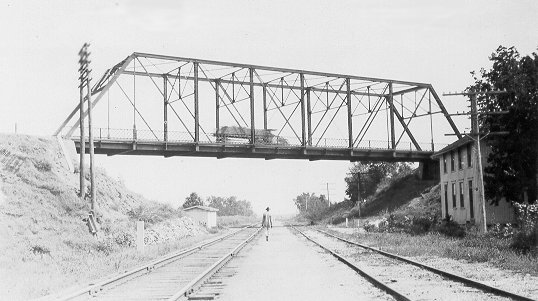|
PRATT HALF-HIP PONY TRUSS
1902 Kay 36E0270N3250005 American Br.
1907 Payne 60E0590N3170009 Joliet Br.
1908 Harper 30E0030N1810009 Canton Br.
1910 Comanche 16E1650N2360001
1910 Comanche 16E1560N2640005
1910 Creek 19N3630E0640009 Missouri Valley Br.
1911 Kay 36E0040N3220006 Canton Br.
1912 Washington 74N4040E0005009 Rochester Br.
1915 Blaine 06N2640E0620008 Canton Br.
1915 Kay 36N3210E0090006 Canton Br.
1919 Pawnee 59E0520N3580009
1927 Pawnee 59E0530N3580009 Central Const.
1932 Creek 19E0750N3750002 Vincennes Br.
Bridge engineers constantly looked for ways to reduce the cost of steel bridges without also diminishing their strength or longevity. The inherent qualities of the Pratt configuration invited this experimentation and led to new variations, such as the Pratt half-hip pony. In this design the hip vertical--the first vertical member beyond the end post--is eliminated and the end post made more perpendicular, thereby simplifying the structure and requiring less metal. Bridges of this kind sold for less, and Oklahoma countiew made it a popular choice; 129 remain as evidence of their extent in earlier times.
Half-hip Pratts came from the shops of companies well represented in the state sa builders of trusses, among them the Canton Bridge Company, which often identified theirs with a nameplate that covered the joint at the end post. The same distinctive coverplate was used by the Central Concrete and Construction Company, very likely an affilate of Canton Bridge (Figure 50). The oldest documented half-hip pony spans a creek southwest of Tonkawa in Kay County. The county acquired the 59-foot bridge in 1902 from the American Bridge Company of New York, then a recently formed consolidation of builders put together by banker J. P. Morgan that ws labeled the "bridge trust." Over Stillwater Creek in Payne County stands the only example of a span fabricated by the Joliet Bridge and Iron Company of Joliet, Illinois, that did not often build in the Southwest. Blaine County has an unusual two span half-hip, each 50 feet in length, with pins and rivets, that dates from about 1915, somewhat late for using this type (Figure 51).
|



